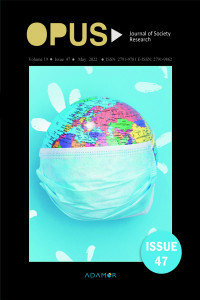Türkiye, Lübnan ve Ürdün'de Bulunan Suriyeli Göçmenlerin Sağlık Hizmetlerine Erişimleri ve Hizmetlerin Sağlanması ile İlgili Karşılaştırmalı Bir Değerlendirme
Suriyeli Mülteciler, Suriyelilerin Sağlık Sorunları, Ürdün, Lübnan, Türkiye
A comparative Study of Syrian Refugees in Turkey, Lebanon, and Jordan: Healthcare Access and Delivery
Syrian Refugees, Refugees' Health Issues, Jordan, Lebanon, Turkey,
___
- 2020, L. C. R. P.-., & http://data.unhcr.org/syrianrefugees/regional.php., a. o. h. w. L. g. l. a.
- Akdağ, R. (2011). Turkey Health Transformation Program Evaluation Report (2003-2010). TC Sağlık Bakanlığı Yayını.
- Akinci, F., Mollahaliloğlu, S., Gürsöz, H., & Öğücü, F. (2012). Assessment of the Turkish health care system reforms: A stakeholder analysis. Health Policy, 107(1), 21-30.
- Aras, N. E. G., & Mencutek, Z. S. (2015). The international migration and foreign policy nexus: the case of Syrian refugee crisis and Turkey. Migration Letters, 12(3), 193.
- Atun, R., Aydın, S., Chakraborty, S., Sümer, S., Aran, M., Gürol, I., . . . Ayar, B. (2013). Universal health coverage in Turkey: enhancement of equity. The Lancet, 382(9886), 65-99.
- Atun, R., Aydın, S., Chakraborty, S., Sümer, S., Aran, M., Gürol, I., . . . Akdağ, R. (2013). Universal health coverage in Turkey: enhancement of equity. The Lancet, 382(9886), 65-99. doi:http://dx.doi.org/10.1016/S0140-6736(13)61051-X
- Burgess, A. (2004). Health challenges for refugees and immigrants. Refugee Reports, 25(2), 1-3.
- CONFLICT, A. Culture, Context and the Mental Health and Psychosocial Wellbeing of Syrians.
- Dadzie, G. M. (2017). Healthcare Accessibility for Syrian Refugees: Understanding Trends, Host Countries’ Responses and Impacts on Refugees’ Health. State University Of New York.
- Doedens W, e. a., Reproductive Health Services for Syrian Refugees in Zaatri Refugee Camp and Irbid City, Jordan. 2013.
- Doocy, S., et al., Syrian Refugee Health Access Survey in Jordan. 2014, Johns Hopkins University Bloomberg School of Public Health, World Health Organization, Jordan University for Science and Technology, United Nations High Commissioner for Refugees, , & Jordan., M. o. H. o. t. H. K. o.
- Doocy, S., Lyles, E., Roberton, T., Akhu-Zaheya, L., Oweis, A., & Burnham, G. (2015). Prevalence and care-seeking for chronic diseases among Syrian refugees in Jordan. BMC Public Health, 15(1), 1097.
- El-Khatib, Z., Scales, D., Vearey, J., & Forsberg, B. C. (2013). Syrian refugees, between rocky crisis in Syria and hard inaccessibility to healthcare services in Lebanon and Jordan. Confl Health, 7(1), 18.
- http://data.unhcr.org/syrianrefugees/regional.php.
- http://www.unhcr.org/en-us/syria-emergency.html.
- http://www.vdc-sy.info/index.php/en/martyrs/1/c29ydGJ5PWEua2lsbGVkX2RhdGV8c29ydGRpcj1ERVNDfGFwcHJvdmVkPXZpc2libGV8ZXh0cmFkaXNwbGF5PTB8Nz0lM0MxOHw=. https://www.unicefusa.org/stories/mission/emergencies/conflict/syria/infographic-syrian-children-under-siege/582.
- Human Rights Watch. Death By Chemicals, T. S. G. s. W. a. S. U. o., & 978-1-6231-34693, C. W. M. I.
- Joiner, T. E., Sachs-Ericsson, N. J., Wingate, L. R., Brown, J. S., Anestis, M. D., & Selby, E. A. (2007). Childhood physical and sexual abuse and lifetime number of suicide attempts: A persistent and theoretically important relationship. Behaviour research and therapy, 45(3), 539-547.
- Kirişci, K. (2014). Syrian refugees and Turkey's challenges: Going beyond hospitality: Brookings Washington, DC.
- Lydia de Leeuw (2015). The situation of older refugees and refugees with disabilities, i., and chronic diseases in the Syria crisis. Field Exchange 48, November 2014. p90. www.ennonline.net/fex/48/thesituation.
- Masterson, A. R., Usta, J., Gupta, J., & Ettinger, A. S. (2014). Assessment of reproductive health and violence against women among displaced Syrians in Lebanon. BMC women's health, 14(1), 25.
- Ministry of Health. (2010). Health Transformation Program in Turkey. Retrieved from http://www.saglik.gov.tr/EN/dosya/2-1251/h/healthtransformationprogrammeinturkey.pdf
- OECD. (2014). OECD Reviews of Health Care Quality: Turkey 2014: OECD Publishing.
- Ozaras, R., Leblebicioglu, H., Sunbul, M., Tabak, F., Balkan, I. I., Yemisen, M., . . . Ozturk, R. (2016). The Syrian conflict and infectious diseases. Expert review of anti-infective therapy, 14(6), 547-555.
- Rashad, H., & Zaky, H. (2014). A comparative analysis of fertility plateau in Egypt, Syria and Jordan: policy implications.
- Save the Children, T. Y. t. W. T. g. p. o. c. m. a. S. g. i. J., Save the Children Fund: London, United Kingdom.
- Services, U. S. D. o. H. a. H., Prevention, C. f. D. C. a., Diseases., N. C. f. E. a. Z. I., & Division of Global Migration and Quarantine SYRIAN REFUGEE HEALTH PROFILE. December 22.
- Sirin, S. R., & Rogers-Sirin, L. (2015). The educational and mental health needs of Syrian refugee children: Migration Policy Institute.
- Tatar, M., Mollahaliloglu, S., Sahin, B., Aydın, S., Maresso, A., & Hernández-Quevedo, C. (2011). Health Systems in Transition. Health, 13(6).
- Tekin, A., Karadag, H., Suleymanoglu, M., Tekin, M., Kayran, Y., Alpak, G., & Sar, V. (2016). Prevalence and gender differences in symptomatology of posttraumatic stress disorder and depression among Iraqi Yazidis displaced into Turkey. Eur J Psychotraumatol, 7, 28556. doi:10.3402/ejpt.v7.28556
- The World Bank. (2017). World Development Indicators. Retrieved from http://databank.worldbank.org/data/reports.aspx?source=2&country=TUR
- UNICEF. (2017). UNICEF Syria Crisis Situation Report August 2017 - Humanitarian Results. Retrieved from https://reliefweb.int/report/syrian-arab-republic/unicef-syria-crisis-situation-report-august-2017-humanitarian-results
- USAID. Child, E., and Forced Marriage: United States Government's Response. 2014 [cited 2016 March 22]; Available from: https://www.usaid.gov/news-information/fact-sheets/child-early-and-forced-marriage-usg-response.
- WHO warns of increased risk of disease epidemics in Syria and in neighbouring countries as summer approaches, J. A. a. h. w. e. w. i. p.-r.
- World Development Indicators 2015. Washington, D. W. B., & http://www.worldbank.org, d.-L. C. C. A. C. B. I. A. a.
- World Health Organization. (2012). Successful health system reforms: the case of Turkey. Geneva: World Health Organization.
- World Health Organization. (2013). Country Cooperation Strategy. Retrieved from http://www.who.int/countryfocus/cooperation_strategy/ccsbrief_tur_en.pdf
- Yayın Aralığı: Yılda 6 Sayı
- Başlangıç: 2011
- Yayıncı: ADAMOR Toplum Araştırmaları Merkezi
Öğretmen Adaylarında Psikolojik Sağlamlık
Rumeysa HOŞOĞLU, Aynur FIRINCI KODAZ, Tuğba YILMAZ BİNGÖL, Meryem VURAL BATIK
19. Yüzyıl Sonrası Yeni Sosyal Hareketler
Pozitif Değerler Ölçeğini Türk Kültürüne Uyarlama Çalışması
Okul Öncesi Dönem Çocukların Ahlaki ve Sosyal Kural Bilgilerinin İncelenmesi
‘İşgal Edilmiş Devlet’: Modern Devletin İkili Yapısı Üzerine Kavramsal Bir Bakış
Öğrenci Motivasyonunu Artıran ve Azaltan Öğretmen Davranışlarının İncelenmesi
Çözüm Odaklı Kısa Süreli Yaklaşıma Dayalı Grup Rehberliği Programının Öz-Yeterlik İnancına Etkisi
Tuğba YILMAZ BİNGÖL, Ahmet Akın
Yalnızlığı Azaltma Psiko-Eğitim Programının Yaşlıların Yalnızlık Düzeyine Etkisi
Hanife AKGÜL, Binnur YEŞİLYAPRAK
12 Mart 1971 Askerî Müdahalesi Sonrası Ara Rejim ve Türkiye Siyasetine Etkileri (1971-1974)
